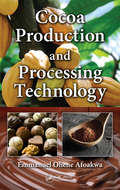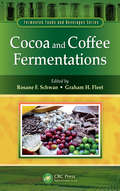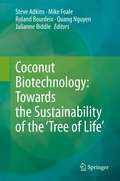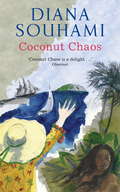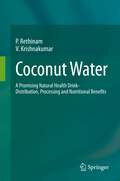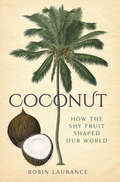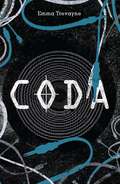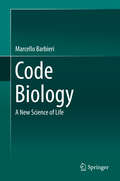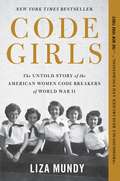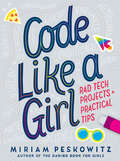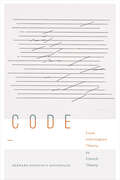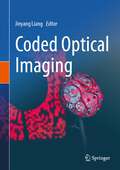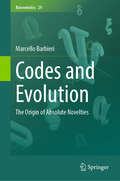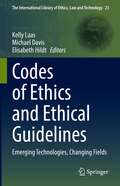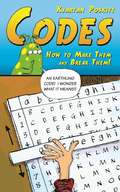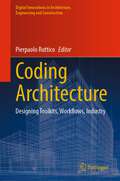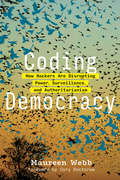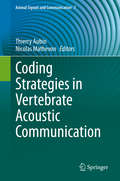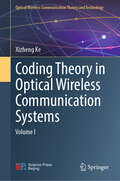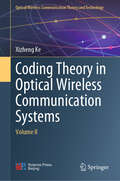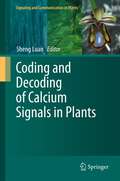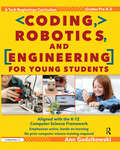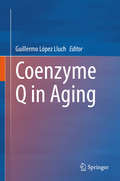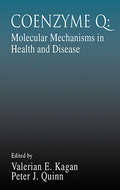- Table View
- List View
Cocoa Production and Processing Technology
by Emmanuel Ohene AfoakwaThis book presents detailed explanations of technologies for sustainable production of high-quality and safe cocoa beans for the global confectionary industry. It describes up-to-date technologies and approaches to modern cocoa production practices, global production and consumption trends as well as principles of cocoa processing and chocolate manufacture. It covers the origin, history and taxonomy of cocoa, and examines the fairtrade and organic cocoa industries. The chapters provide in-depth coverage of cocoa cultivation, harvesting and post-harvest treatments, genotypic variations, fermentation techniques, drying, storage and transportation.
Cocoa and Coffee Fermentations (Fermented Foods and Beverages Series)
by Graham H. Fleet Rosane F. SchwanThis is the first book to focus on the scientific principles underlying the fermentation processes of cocoa and coffee beans and their impact on product quality and safety. The text compiles the knowledge from the different disciplines involved in fermentation, including botany, chemistry, microbiology, biochemistry, food science, and sensory science. The chapters discuss the botanics of the beans; fermentation methods; the microbiology of fermentation; the biochemistry and physiology of fermentation; the impacts of fermentation on bean flavor, quality, and safety; chocolate and coffee derived from the beans; and the processing of waste materials.
Coconut Biotechnology: Towards the Sustainability of the ‘Tree of Life’
by Steve Adkins Mike Foale Roland Bourdeix Quang Nguyen Julianne BiddleWidely known as the ‘tree of life’, coconut (Cocos nucifera L.) provides a bountiful source for making a wide variety of healthy foods and industrial items. Its cultivation, however, has been encountering seriously destructive issues including lethal diseases and natural adversities which are currently distressing livelihoods of millions of small-holder farmers around the world. There is an urgent mandate to resolve these issues by meeting sustainable seedling production, facilitating genetic conservation, as well as developing disease identification and modern breeding. This book introduces improvements in coconut biotechnology by covering the advances in micropropagation, germplasm conservation, and molecular pathogenic diagnosis. This comprehensive volume will be a useful source of information and references to researchers, graduate students, agricultural developers, and scholars in the plant sciences. In order to benefit general readers, the book also covers fundamental aspects of biology, diversity, and evolution of this marvelous palm species.
Coconut Chaos: Pitcairn, Mutiny And A Seduction At Sea
by Diana SouhamiAt dawn on 27 April 1789 Fletcher Christian, master's mate on HMS Bounty, took a coconut to quench his thirst from the supply on the quarterdeck. This seemingly insignificant act resulted in mutiny, chaos and a chain of events that leads right up to the present day. With a story driven by hazardous and extraordinary sea voyages and a cast that includes the Bounty mutineers, an eccentric lesbian aristocrat, Pitcairn Island sex offenders and the narrator's ancient mother, this sparkling and original book weaves together fact and fiction, history and autobiography, humour and danger in inimitable style.
Coconut Water: A Promising Natural Health Drink-Distribution, Processing and Nutritional Benefits
by V. Krishnakumar P. RethinamCoconut water, a naturally-canned tropical beverage, has been gaining popularity in recent years and has drawn the attention world over as a natural and nutritional wellness beverage. The research published thus far on coconut water has mainly focused on its specific uses, biochemical composition and health benefits as well as processing and preservation techniques and has been published mostly in journal articles. Only a few books covering a wide spectrum of coconut water for health and wellness are currently available. This work offers a comprehensive and fully updated overview of coconut water from processing techniques to value addition to safety to nutritional benefits and beyond. Coconut Water: Processing, Distribution & Nutritional Benefits provides in-depth details on all of the major processing techniques required to produce and maintain a quality product free of contamination and adulteration. The book covers the standards of coconut water production and distribution in various countries enabling the processors and exporters to manufacture and export for better revenue realization. The book also provides details of patents related to coconut water granted to researchers. Another important aspect of this work is comprehensive coverage on the various nutritional and health benefits of coconut water consumption as well as on the value addition (traditional and innovative products). In markets across the world, consumers of all ages have been turning to coconut water for its taste and nutritional benefits. This book will provide researchers, processors and exporters the comprehensive information needed to produce and market quality, nutritional coconut water for consumers.
Coconut: How the Shy Fruit Shaped our World
by Robin LauranceCoconuts have been around for longer than Homo sapiens; they have been turned into art, taken part in religious rituals and been a sign of wealth and success. They have saved lives, not only by providing nourishment, but also as part of the charcoal filers in First World War gas masks. It was coconuts that triggered the mutiny on the Bounty, and coconuts that saved the life of the man who went on to become the 35th President of the United States. The coconut has long been the unseen player in the endeavours of industrialists and bomb makers, physicians and silversmiths, smugglers and snake charmers. To this day, coconuts shape the lives of people around the world. At a time when coconut products crowd the shelves of supermarkets, health food shops and beauty salons, Robin Laurance looks beyond the oils and health drinks to uncover the unexpected, often surprising, and vital roles played by the coconut palm and its nut in times past and present.
Coda
by Emma TrevayneRevolution sings in the air when a teenage boy plays illegal, underground music in a dystopian, Corp-controlled world.
Code Biology: A New Science of Life
by Marcello BarbieriThis book is the study of all codes of life with the standard methods of science. The genetic code and the codes of culture have been known for a long time and represent the historical foundation of this book. What is really new in this field is the study of all codes that came after the genetic code and before the codes of culture. The existence of these organic codes, however, is not only a major experimental fact. It is one of those facts that have extraordinary theoretical implications. The first is that most events of macroevolution were associated with the origin of new organic codes, and this gives us a completely new reconstruction of the history of life. The second implication is that codes involve meaning and we need therefore to introduce in biology not only the concept of information but also the concept of biological meaning. The third theoretical implication comes from the fact that the organic codes have been highly conserved in evolution, which means that they are the greatest invariants of life. The study of the organic codes, in short, is bringing to light new mechanisms that have operated in the history of life and new fundamental concepts in biology.
Code Girls: The Untold Story of the American Women Code Breakers of World War II
by Liza MundyThe award-winning New York Times bestseller about the American women who secretly served as codebreakers during World War II--a "prodigiously researched and engrossing" (New York Times) book that "shines a light on a hidden chapter of American history" (Denver Post).Recruited by the U.S. Army and Navy from small towns and elite colleges, more than ten thousand women served as codebreakers during World War II. While their brothers and boyfriends took up arms, these women moved to Washington and learned the meticulous work of code-breaking. Their efforts shortened the war, saved countless lives, and gave them access to careers previously denied to them. A strict vow of secrecy nearly erased their efforts from history; now, through dazzling research and interviews with surviving code girls, bestselling author Liza Mundy brings to life this riveting and vital story of American courage, service, and scientific accomplishment.
Code Like a Girl: Rad Tech Projects And Practical Tips
by Miriam PeskowitzWelcome to Code Like a Girl, where you'll get started on the adventure of coding with cool projects and step-by-step tips, from the co-author of the bestselling The Daring Book for Girls.Coding is about creativity, self-expression, and telling your story. It's solving problems and being curious, building things, making the world a better place, and creating a future. It's about you: whoever you are, wherever you're at, whatever you want. Nearly everything you encounter on a screen is made from code. You see, with code you can have an idea and put it into action: it's your voice and your vision. From the outside, tech and code may seem puzzling and mysterious, but when you get through the door and past the first few beginner steps and your code starts to work, it feels like magic. <P><P>In this book, you'll learn how to: <li> Code with Scratch <li> projects like making a dog walk through the park, sending your friend a card, and devising a full-scoring game! <li> Build your own computer--really! <li> Create your own digital fortune-teller, with the Python language. <li> Make your own smartphone gloves. <li> Make light-up bracelets. <li> Code a motion sensor that tells you when someone enters your room. <li> And lots more!
Code as Creative Medium: A Handbook for Computational Art and Design
by Golan Levin Tega BrainAn essential guide for teaching and learning computational art and design: exercises, assignments, interviews, and more than 170 illustrations of creative work.This book is an essential resource for art educators and practitioners who want to explore code as a creative medium, and serves as a guide for computer scientists transitioning from STEM to STEAM in their syllabi or practice. It provides a collection of classic creative coding prompts and assignments, accompanied by annotated examples of both classic and contemporary projects, and more than 170 illustrations of creative work, and features a set of interviews with leading educators. Picking up where standard programming guides leave off, the authors highlight alternative programming pedagogies suitable for the art- and design-oriented classroom, including teaching approaches, resources, and community support structures.
Code: From Information Theory to French Theory (Sign, Storage, Transmission)
by Bernard Dionysius GeogheganIn Code Bernard Dionysius Geoghegan reconstructs how Progressive Era technocracy as well as crises of industrial democracy and colonialism shaped early accounts of cybernetics and digital media by theorists including Norbert Wiener, Warren Weaver, Margaret Mead, Gregory Bateson, Claude Lévi-Strauss, Roman Jakobson, Jacques Lacan, Roland Barthes, and Luce Irigaray. His analysis casts light on how media-practical research forged common epistemic cause in programs that stretched from 1930s interwar computing at MIT and eugenics to the proliferation of seminars and laboratories in 1960s Paris. This mobilization ushered forth new fields of study such as structural anthropology, family therapy, and literary semiology while forming enduring intellectual affinities between the humanities and informatics. With Code, Geoghegan offers a new history of French theory and the digital humanities as transcontinental and political endeavors linking interwar colonial ethnography in Dutch Bali to French sciences in the throes of Cold War-era decolonization and modernization.
Coded Optical Imaging
by Jinyang LiangThis book provides a comprehensive survey of coded optical imaging. Illustrated with 386 figures, it takes readers from the fundamental concepts and theories to the latest research and applications in this field. It can be used in graduate-level courses in optics and photonics. It can also benefit scientists and engineers in optical imaging, computer graphics, and other related disciplines. This book starts from a brief history of coded optical imaging and key operations in its data acquisition and image reconstruction. It then presents the latest progress in technological development and applications in the areas of biomedicine, materials science, industrial inspection, optical physics, imaging science, information theory, and more. Chapters describe the most representative techniques, exposing readers to key research themes, including: · Optical signal encoding · Image reconstruction techniques · Compressed sensing · Artificial intelligence · Metasurface · Structured light · Lensless imaging · Holography · Tomography · Light-field imaging · Utrafast imaging · Hyperspectral imaging · Polarization imaging · Super-resolution imaging
Codes and Evolution: The Origin of Absolute Novelties (Biosemiotics #29)
by Marcello BarbieriThis text builds upon the over 1500 papers published in peer-reviewed journals revealing that there are more than 200 biological codes in living systems. The author claims this experimental fact is bound to change biology forever. This book shows how this very discovery reveals that coding is a new mechanism of life, just as the discovery of electromagnetism revealed the existence of a new physical force in the universe. The existence of many biological codes, furthermore, Barbieri argues, is one of those experimental facts that have extraordinary theoretical consequences. It implies that coding is not only a mechanism that constantly operates in all living systems, but also a mechanism of evolution, more precisely a mechanism that gave origin to the absolute novelties of the history of life. This amounts to saying that evolution took place by two distinct mechanisms, by natural selection and by natural conventions, two mechanisms that are fundamentally different because natural selection is the result of copying and deals with information whereas natural conventions are the result of coding and deal with meaning. This volume appeals to students and researchers working in the fields of semiotics, philosophy, biology and mathematics.
Codes of Ethics and Ethical Guidelines: Emerging Technologies, Changing Fields (The International Library of Ethics, Law and Technology #23)
by Michael Davis Elisabeth Hildt Kelly LaasThis book investigates how ethics generally precedes legal regulation, and looks at how changes in codes of ethics represent an unparalleled window into the research, innovation, and emerging technologies they seek to regulate. It provides case studies from the fields of engineering, science, medicine and social science showing how professional codes of ethics often predate regulation and help shape the ethical use of emerging technologies and professional practice. Changes in professional ethics are the crystallization of ongoing conversation in scientific and professional fields about how justice, privacy, safety and human rights should be realized in practice where the law is currently silent. This book is a significant addition to this area of practical and professional ethics and is of particular interest to practitioners, scholars, and students interested in the areas of practical and applied ethics.
Codes: How to Make Them and Break Them! (Murderous Maths Ser.)
by Ian Baker Kjartan PoskittDid you ever want to send a message that only your friend can read? Or did you want to try and uncover a secret communication from someone else? If so, then here's everything you need to know about creating and cracking codes-from the simplest substitution messages to the secrets of the well-known World War II coding contraption, the amazing Enigma Machine!The book includes information about:Substitution codesScrambling codesCodes containing unrecognizable symbolsOther message systems such as Morse code and flagsAnd how to make your own Enigma machine!You’ll be thrilled as this amusing book takes you on a codebreaking adventure, learning ways to decode both simple and difficult puzzles, as well as provides you with a history on the cryptology. Filled with tips and enjoyable illustrations by Ian Baker, Codes will have you sending secret messages in no time.
Coding Architecture: Designing Toolkits, Workflows, Industry (Digital Innovations in Architecture, Engineering and Construction)
by Pierpaolo RutticoThis book provides a clear picture of how computational processes are gradually permeating and innovating the Architecture, Engineering, and Construction sector, contributing to sustainability and aesthetic evolution. It achieves that by gathering a collection of accounts shared by pioneering professionals involved in this innovation, drawing from recent academic studies, ongoing experimental processes conducted in cutting-edge architectural and engineering offices, as well as innovative industrial applications. The covered subjects span a wide range, including artificial intelligence and robotic manufacturing, the metaverse and 3D printing, strategies to counter CO2 consumption through plug-ins, as well as emerging materials and construction techniques. The chapters feature authors who are pioneers and embrace roles like software developers, architects, process engineers, academics, and forward-thinking entrepreneurs. They represent authoritative references within a broader interconnected cultural and technological system; an eclectic system that finds in computational processes the key to addressing the new challenges of contemporary architecture.
Coding Democracy: How Hackers Are Disrupting Power, Surveillance, and Authoritarianism (The\mit Press Ser.)
by Maureen WebbHackers as vital disruptors, inspiring a new wave of activism in which ordinary citizens take back democracy.Hackers have a bad reputation, as shady deployers of bots and destroyers of infrastructure. In Coding Democracy, Maureen Webb offers another view. Hackers, she argues, can be vital disruptors. Hacking is becoming a practice, an ethos, and a metaphor for a new wave of activism in which ordinary citizens are inventing new forms of distributed, decentralized democracy for a digital era. Confronted with concentrations of power, mass surveillance, and authoritarianism enabled by new technology, the hacking movement is trying to “build out” democracy into cyberspace.Webb travels to Berlin, where she visits the Chaos Communication Camp, a flagship event in the hacker world; to Silicon Valley, where she reports on the Apple-FBI case, the significance of Russian troll farms, and the hacking of tractor software by desperate farmers; to Barcelona, to meet the hacker group XNet, which has helped bring nearly 100 prominent Spanish bankers and politicians to justice for their role in the 2008 financial crisis; and to Harvard and MIT, to investigate the institutionalization of hacking. Webb describes an amazing array of hacker experiments that could dramatically change the current political economy. These ambitious hacks aim to displace such tech monoliths as Facebook and Amazon; enable worker cooperatives to kill platforms like Uber; give people control over their data; automate trust; and provide citizens a real say in governance, along with capacity to reach consensus. Coding Democracy is not just another optimistic declaration of technological utopianism; instead, it provides the tools for an urgently needed upgrade of democracy in the digital era.
Coding Strategies in Vertebrate Acoustic Communication (Animal Signals and Communication #7)
by Thierry Aubin Nicolas MathevonInformation is a core concept in animal communication: individuals routinely produce, acquire, process and store information, which provides the basis for their social life. This book focuses on how animal acoustic signals code information and how this coding can be shaped by various environmental and social constraints. Taking birds and mammals, including humans, as models, the authors explore such topics as communication strategies for “public” and “private” signaling, static and dynamic signaling, the diversity of coded information and the way information is decoded by the receiver. The book appeals to a wide audience, ranging from bioacousticians, ethologists and ecologists to evolutionary biologists. Intended for students and researchers alike, it promotes the idea that Shannon and Weaver’s Mathematical Theory of Communication still represents a strong framework for understanding all aspects of the communication process, including its dynamic dimensions.
Coding Theory in Optical Wireless Communication Systems: Volume I (Optical Wireless Communication Theory and Technology)
by Xizheng KeThis book focuses on optical-wireless communication systems. It summarizes the author's optical-wireless communication coding work while carrying out pertinent scientific research programs. The primary topics covered in the book are channel coding, coding modulation, error control (channel coding), and channel equalization. The author's mathematical analysis and experimental studies on the key theoretical issues are discussed in the book. One of the book's outstanding aspects is its thorough and methodical discussion of practical optical-wireless communication challenges. This makes the book especially appealing to readers who are eager to learn about applicable solutions in this area. Researchers, engineers, and graduate students in the subject of telecommunications can all profit from the book. It is appropriate for senior undergraduates, lecturers at colleges and universities, graduate students, and engineering and technical workers involved in optical communication.
Coding Theory in Optical Wireless Communication Systems: Volume II (Optical Wireless Communication Theory and Technology)
by Xizheng KeThis book focuses on optical-wireless communication systems. It summarizes the author's optical-wireless communication coding work while carrying out pertinent scientific research programs. The primary topics covered in the book are channel coding, coding modulation, error control (channel coding), and channel equalization. The author's mathematical analysis and experimental studies on the key theoretical issues are discussed in the book. One of the book's outstanding aspects is its thorough and methodical discussion of practical optical-wireless communication challenges. This makes the book especially appealing to readers who are eager to learn about applicable solutions in this area. Researchers, engineers, and graduate students in the subject of telecommunications can all profit from the book. It is appropriate for senior undergraduates, lecturers at colleges and universities, graduate students, and engineering and technical workers involved in optical communication.
Coding and Decoding of Calcium Signals in Plants (Signaling and Communication in Plants #10)
by Sheng LuanPlants cannot move away from their environments. As a result, all plants that have survived to date have evolved sophisticated signaling mechanisms that allow them to perceive, respond, and adapt to constantly changing environmental conditions. Among the many cellular processes that respond to environmental changes, elevation of calcium levels is by far the most universal messenger that matches primary signals to cellular responses. Yet it remains unclear how calcium, a simple cation, translates so many different signals into distinct responses - how is the "specificity" of signal-response coupling encoded within the calcium changes? This book will attempt to answer this question by describing the cellular and molecular mechanisms underlying the coding and decoding of calcium signals in plant cells.
Coding, Robotics, and Engineering for Young Students: A Tech Beginnings Curriculum (Grades Pre-K-2)
by Ann GadzikowskiCoding, Robotics, and Engineering for Young Students builds foundational computer science and robotics skills and knowledge in bright Pre-K-grade 2 students. Originally developed as enrichment courses for Northwestern University's Center for Talent Development, this curriculum emphasizes active, hands-on, and collaborative learning. Students are challenged to learn computer science content, such as coding, and robotics and engineering concepts, as well as practice high-level academic skills, such as creative problem solving, computational thinking, and critical thinking. Instructional practices balance screen time with active, collaborative classroom engagement. Learning is deepened when students are challenged to navigate the transition from a virtual learning environment to a tangible learning environment. The lessons can be implemented as standalone enrichment experiences or as part of a coordinated scope and sequence that leads to higher level computer science and engineering studies.Grades Pre-K-2
Coenzyme Q in Aging
by Guillermo López LluchThis book offers a comprehensive exploration of research on the essential relationship of the coenzyme Q10 and the process of aging in living organisms. CoQ10 is an important factor in two main aspects of cell physiology: bioenergetics and antioxidant protection. While primary deficiency of CoQ10 is associated with severe and lethal disease, secondary deficiency can be associated with the progression of mitochondrial dysfunction linked to the lessening of biological activities during aging. The book is organized in four sections. The first offers an overview of the function of CoQ10, highlighting the two main functions of CoQ10 in cells: its essential role as electron transport chain member in mitochondria, and the protection of cell membranes against oxidation as one of the main endogenous-synthesized antioxidants. The second section covers research on Coenzyme 10. Topics include studies involving invertebrate models, mammal studies and the influence of CoQ on longevity. Also covered is research involving the role of CoQ in senescence-accelerated mice. Section three examines the effects of reduced CoQ in human aging, as evident in mitochondrial dysfunction, metabolic syndrome, neurodegenerative disorders, immunosenescence and fertility and reproduction. The final section, Prolongevity effectors and Coenzyme Q, explores research into slowing or stopping the aging process. Coverage includes strategies including calorie restriction, and modulation of CoQ10 levels by induction of synthesis or by supplementation. Coenzyme Q in Aging benefits a broad readership of researchers, clinicians, educators and students interested in the biochemical and physiological effects of coenzyme Q and the importance of this molecule in aging process.
Coenzyme Q: Molecular Mechanisms in Health and Disease (Modern Nutrition)
by Peter J. Quinn Valerian E. KaganSince its discovery in 1957, Coenzyme Q has piqued the interest of scientists from a wide range of disciplines because of its bioenergetics, vitamin-like behavior, and interactions with antioxidant vitamins E and C. Coenzyme Q: Molecular Mechanisms in Health and Disease is a comprehensive treatise on this often-studied coenzyme. International exper
